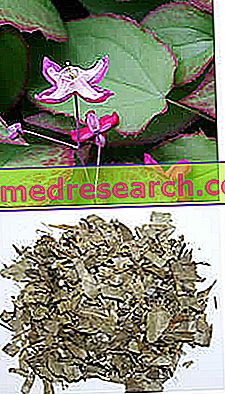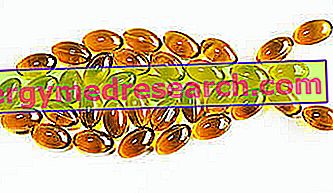The Epimedium - also called Horny Goat Weed (dry goat weed) - is a medicinal herb that has been used in traditional Chinese medicine for centuries to support reproductive capacity and the functions of the musculoskeletal system.

In recent years, the Epimedium has reached the headlines thanks to its marked tonic activities, allowing different research groups to characterize their chemical composition and identify the main elements endowed with therapeutic activity. Careful chemical-analytical studies have therefore allowed to identify:
- Flavonoids;
- Polysaccharides with biological activity;
- C vitamin;
- Icariin, the active ingredient that currently seems to be the main culprit of the invigorating action of the Epimedium.
Flavonoids in Epimedium
The total proportion of flavonoids present in the Epidemium seems to be mainly responsible for the antioxidant and cardioprotective activity attributed to this plant.
Numerous studies conducted on experimental models have in fact demonstrated that flavonoids cause a reduction in the edema associated with phlogosis, oxidized LDL, Prostaglandin E concentrations and oxidation markers, including malonyl sialdehyde.
Also interesting are the data of other studies, which identify the cardioprotective potential of Epimedium, highlighting the ability of its flavonoids to control cytological damage induced by reactive oxygen species or hypoxia related to myocardiocytes.
Recent studies, dated at the latest 2012, however, always conducted on experimental models, also demonstrate how these flavonoids can counteract the side effects of numerous drugs, such as glucocorticoids; furthermore, through intracellular molecular mechanisms, they can activate the osteogenic component, controlling the osteoriasorbent action of osteoclasts and thus significantly improving bone health conditions.
Polysaccharides in Epimedium
Careful chemical-physical studies have shown that the proportion of polysaccharides present in the Epimedium is between 19% and 31%, with a prevalence of monosaccharides such as mannose, glucose, 6 deoxymannose, galactose, arabinose and galacturonic acid.
In addition to the evidently energetic role, different studies have attributed to this fraction:
- antimicrobial and immunoprotective properties, probably induced by the ability to activate the immune system of mucous membranes, in particular that associated with the gastrointestinal system;
- indirect antioxidant properties, as demonstrated by the increase in superoxide dismutase and glutathione peroxidase concentrations, protagonists of the antioxidant response;
- direct antioxidant properties, as observed on the cellular quality of myocardiocytes subjected to oxidative stress.
Everything has been observed in various experimental models consisting of cellular elements and guinea pigs from laboratories such as mice, rats and chickens.
Vitamin C in Epimedium
Despite the content of Vitamin C varies considerably from plant to plant, depending on the methods of cultivation, extraction and processing, the proportion still seems effective both in helping the antioxidant function of plavonoids and polysaccharides, and in contributing to the typical ergogenic and metabolic capacities of ascorbic acid.
Studies show that the association of vitamin C and flavonoids present in Epimedium may lower serum levels of cholesterol and triglycerides, a reduction in endothelial damage, and a greater protective contribution against damage induced by reactive oxygen species.
Icariin

Analytical chemistry studies define the maximum content of Icariin around 2.7%, on average equal to 14.24 mg / g of product.
Given its chemical nature, it is easy to attribute a predominantly antioxidant role to Icariin; in line with the main experimental evidence, a role can be attributed to this active ingredient:
- antioxidant, protecting cells of different tissues, in particular of the myocardium, from the damage induced by hypoxia and reactive oxygen species;
- neuroprotective, as demonstrated against peripheral nerves of rats subjected to injury and chemical-physical stress, and in experimental Alzheimer models, in which the proportion of Beta Amyloid exerted a particularly damaging action on the Central Nervous System;
- osteoprotective, inhibiting the activation of the NfKB parthway responsible for osteoclast-mediated bone resorption;
- cardioprotective, protecting myocardiocytes from the damaging action of reactive oxygen species.
Epimedium and erectile dysfunction
Despite the use of the Epimedium has always been associated with its invigorating and aphrodisiac properties, the modern scientific literature resizes these activities, evidently linking them to the antioxidant properties of the plant, useful for protecting the endothelium from the damaging action of the ROS, with improvement of peripheral blood flow.
Actually, Icariin has been tested in the treatment of erectile dysfunction, which is promising, especially after intracavernous administration of the same.
This activity was generally attributed to two different mechanisms, one of a nervous type - for which Icariin could improve peripheral nerve conduction properties, structurally reinvigorating these nerves and protecting them from the oxidizing action of various chemical species - and one of a kind hemodynamic, which attributes to this active principle the ability to increase local production of Nitric Oxide, thereby increasing the local vascular flow.
Reflections and side effects
Given the vast amount of experimental evidence attributing to this plant preventive and therapeutic properties that are potentially very useful for maintaining the state of cardiac and neurological health, the statistically significant clinical trials carried out so far are scarce. This prevents a clear and definitive evaluation of the biological capacities of the Epimedium.
At the moment, the antioxidant and osteoprotective actions seem to be those most characterized from the clinical point of view, although decidedly modest compared to the wide spectrum of potentialities set out for commercial purposes.
Furthermore, the modest number of studies makes it impossible to fully define the safety of use of this plant, although its use, for limited periods of time and under the supervision of your doctor, seems to be generally safe.
Vomiting, dry mouth, difficulty breathing, and very rarely cardiac conduction disorders, seem to be the side effects classically linked to the inappropriate use of this plant.
Little is known about the potential effects of the Epimedium during pregnancy and lactation; therefore, as a precautionary measure, its use in similar situations is contraindicated.
Currently, Epimedium grandiflorum is included in the list of plant extracts NOT allowed in food supplements, according to the Italian Ministry of Health. However, the plant is subject to intense commercial propaganda which makes it almost ubiquitous in the so-called "natural Viagra", dietary supplements that promise to reinvigorate man's sexual desire and power.
Bibliography
Effect of chinese traditional herb Epimedium grandiflorum C. Morren and its extract Icariin on osteoarthritis via suppressing NF-kappaB pathway.
Zhang W, Li R, Wang S, Mu F, Jia P.
Indian J Exp Biol. 2013 Apr; 5: 512-7. doi: 10.1016 / j.ijbiomac.2012.01.002. Epub 2012 Jan 13.
Herba Epimedii: anti-oxidative properties and its medical implications.
Sze SC, Tong Y, Ng TB, Cheng CL, Cheung HP.
Molecules. 2010 Nov 3; 15 (11): 7861-70. doi: 10.3390 / molecules15117861. Review.
Epimedium polysaccharide and propolis flavone can synergistically stimulate lymphocyte proliferation in vitro and enhance the immune responses to ND vaccine in chickens.
Fan Y, Hu Y, Wang D, Guo Z, Zhao X, Guo L, Zhao B, Zhang J, Wang Y, Nguyen TL.
Int J Biol Macromol. 2010 Aug 1; 47 (2): 87-92. doi: 10.1016 / j.ijbiomac.2010.05.017. Epub 2010 Jun 1.
The changes in polysaccharides and total flavonoids during flower bud differentiation of Epimedium sagittatum].
Wang R, Li YX, Quan QM.
Zhong Yao Cai. 2009 Oct; 32 (10): 1511-4. Chinese.
Epimedium flavonoids counteract the side effects of glucocorticoids on hypothalamic-pituitary-adrenal axis.
Huang J, Li J, Zheng S, Wu J, Zhang W, Sun T, Dewan SK, Kalionis B, Shen Z, Tai X, Xia S.
[Flavonoids from leaves of Epimedium pubescens].
Zhang HF, Yan LH, Zhang QW, Wang ZM.
Zhongguo Zhong Yao Za Zhi. 2013 Jun; 38 (12): 1942-6. Chinese.
Herb-drug interaction of Epimedium sagittatum (Sieb. Et Zucc.) Maxim extract on the pharmacokinetics of sildenafil in rats.
Hsueh TY, Wu YT, Lin LC, Chiu AW, Lin CH, Tsai TH.
Molecules. 2013 Jun 21; 18 (6): 7323-35. doi: 10.3390 / molecules18067323.
The optimization and immune effect of epimediumpolysaccharide-propolis flavone liposome.
Fan Y, Liu J, Wang D, Song X, Hu Y, Zhang C, Zhao X, Nguyen TL.
Carbohydr Polym. 2013 Apr 15; 94 (1): 24-30. doi: 10.1016 / j.carbpol.2012.12.071. Epub 2013 Jan 9.
Effect of Epimedium brevicornum Maxim extract on the stimulation of penile erection in the rat.
Chen KK, Chiu JH.
Urology. 2006 Mar; 67 (3): 631-5.
Erectogenic and neurotrophic effects of icariin, a purified extract of horny goat weed (Epimedium spp.) In vitro and in vivo.
Shindel AW, Xin ZC, Lin G, Fandel TM, Huang YC, Banie L, Breyer BN, Garcia MM, Lin CS, Lue TF.
J Sex Med. 2010 Apr; 7 (4 Pt 1): 1518-28. doi: 10.1111 / j.1743-6109.2009.01699.x. Epub 2010 Feb 5.
Icarisid II, a PDE5 inhibitor from Epimedium wanshanense, increases cellular cGMP by enhancing NOS in diabetic ED rats corpus cavernosum tissue.
Zhang J, Wang YB, Ma CG, Liu T, Li WR, Gong YQ, Xin ZC.
Andrology. 2012 May; 44 Suppl 1: 87-93. doi: 10.1111 / j.1439-0272.2010.01144.x. Epub 2011 Jul 6.



